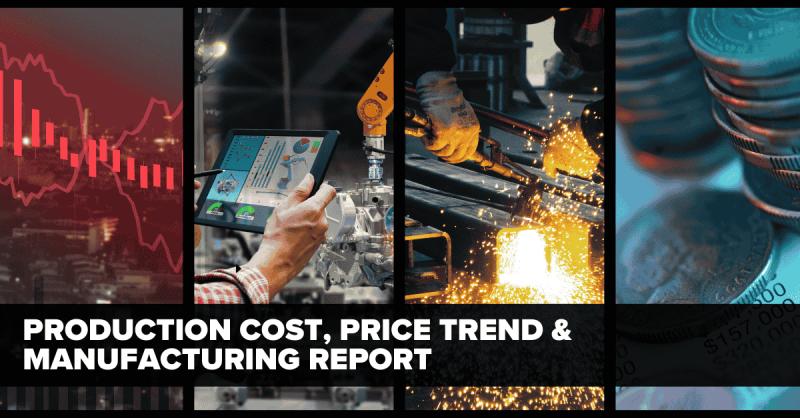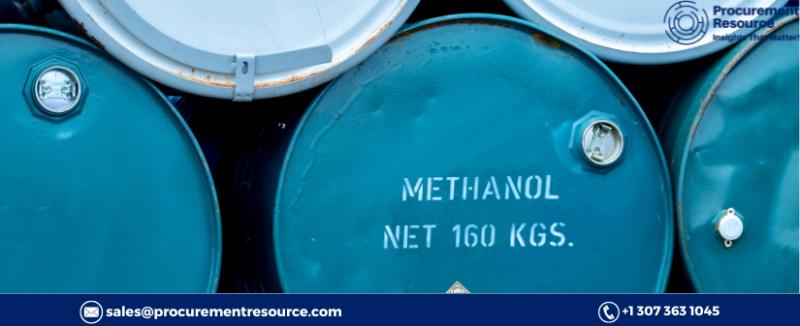Press release
Methanol Production Process with Cost Analysis: A Complete Overview
IntroductionThe Methanol Production Process with Cost Analysis is a detailed exploration of the steps, resources, and costs involved in producing methanol. Methanol, also known as methyl alcohol, is a versatile chemical widely used in various industries, including chemicals, energy, and transportation. In this report, we break down the methanol production process, covering the key raw materials, costs, and market dynamics to provide a comprehensive understanding of this essential compound.
Request Free Sample - https://tinyurl.com/hke3xuu6
Procurement Resource Assessment for Methanol Production Process
The procurement of resources is a crucial component in methanol production. The process involves identifying, sourcing, and assessing the availability and cost of raw materials and equipment necessary for production. A procurement resource assessment ensures the consistent availability of high-quality materials, allowing for stable and efficient production.
Methanol Production Process - https://tinyurl.com/mrx668s8
Sourcing strategies depend on the scale of the production facility, market conditions, and location. It is essential to evaluate suppliers, negotiate favorable contracts, and develop a reliable supply chain. Depending on the production technology, procurement may involve securing sources of natural gas or coal, catalysts, and utilities such as electricity and water. These resources play a vital role in methanol production, and effective procurement planning can lead to cost savings and production stability.
Understanding Methanol
Methanol (CH₃OH) is a colorless, volatile liquid with a distinctive odor. It is widely used as a solvent, antifreeze, fuel, and feedstock in chemical manufacturing. Methanol is also a vital ingredient in producing formaldehyde, acetic acid, and various other chemicals used in resins, plastics, and adhesives.
Methanol production can be achieved using several methods, including natural gas reforming and coal gasification. Natural gas reforming is the most common method due to its efficiency and lower environmental impact. However, coal gasification is also widely used, particularly in regions with abundant coal resources. Methanol is produced by converting a feedstock into synthesis gas (syngas), which is then catalytically converted into methanol.
Market Drivers for Methanol
The demand for methanol is driven by various factors across different industries. Key market drivers include:
Growing Demand in Chemical Manufacturing: Methanol is a building block for several chemicals, including formaldehyde, acetic acid, and methyl tert-butyl ether (MTBE). The chemical industry heavily relies on methanol as a raw material, driving consistent demand.
Renewable Energy and Clean Fuel Initiatives: Methanol is increasingly used as a cleaner-burning alternative to fossil fuels. It can be blended with gasoline or used in fuel cells for vehicles, contributing to reduced emissions. Additionally, methanol-based fuels are becoming popular for marine and industrial applications due to stricter emission regulations.
Expanding Construction Industry: Methanol-derived products, such as formaldehyde, are used in the production of resins and adhesives essential for construction materials like plywood and particleboard. The growing construction industry, especially in developing regions, fuels the demand for methanol.
Advancements in Methanol-to-Olefins (MTO) Technology: Methanol is increasingly used as a feedstock in methanol-to-olefins technology, which produces valuable chemicals like ethylene and propylene. These chemicals are crucial for the plastics industry, creating new opportunities for methanol demand.
Transportation Fuel Applications: Methanol is used as an alternative fuel and fuel additive, particularly in countries with limited oil resources. It can reduce emissions when blended with gasoline and improve fuel efficiency.
Government Support and Regulations: Governments worldwide are encouraging the use of methanol as a clean energy source, providing incentives and subsidies to promote methanol-based fuel technologies. These initiatives drive investment in methanol production infrastructure and research.
Raw Material Requirements for Methanol Production
The production of methanol requires several key raw materials, depending on the specific production process. Here is an overview of the primary materials used:
Natural Gas or Coal: The main feedstock for methanol production is natural gas or coal, depending on the regional availability and cost. Natural gas reforming is the most common method, but coal gasification is also widely used in areas where coal is more accessible.
Water: Water is essential in the production of synthesis gas, particularly in natural gas reforming, where it is used in the form of steam. Steam reforming of methane produces synthesis gas, which is then converted into methanol.
Catalysts: Catalysts are crucial in the conversion of synthesis gas to methanol. Common catalysts include copper-based catalysts, which promote efficient conversion at relatively low temperatures and pressures.
Electricity and Fuel: Methanol production requires energy for various stages, including steam reforming, syngas compression, and methanol synthesis. Electricity and fuel are needed to operate equipment and maintain process temperatures.
Oxygen or Air (in certain processes): Some methanol production methods, such as partial oxidation, require oxygen or air as a reactant. Oxygen is often separated from air and used to promote efficient conversion of feedstock to syngas.
Costs and Key Process Information
The costs associated with methanol production depend on various factors, including feedstock prices, process technology, and plant location. Here are the primary cost components involved:
Feedstock Costs: Feedstock accounts for a significant portion of production costs. Natural gas or coal prices can vary based on market conditions, affecting the overall cost of methanol production. For instance, natural gas prices are typically lower in regions with abundant reserves, making methanol production more cost-effective.
Energy Costs: Energy is required for several stages in the production process, such as syngas generation, methanol synthesis, and product purification. Energy costs depend on the efficiency of the production facility and local energy prices. Integrating renewable energy sources, where feasible, can reduce costs and improve sustainability.
Catalyst and Chemical Costs: Catalysts are essential for converting synthesis gas into methanol, and their performance directly impacts production efficiency. Catalysts must be periodically replaced, leading to recurring costs. Other chemicals, such as solvents and pH adjusters, are also required for the purification process.
Labor and Maintenance Costs: Skilled labor is needed to operate, monitor, and maintain methanol production facilities. Maintenance costs include equipment servicing, repairs, and replacement parts. Automation can help reduce labor costs but requires initial capital investment.
Capital Expenditures: Setting up a methanol production plant requires significant capital investment. Costs include purchasing equipment, constructing facilities, and installing infrastructure. Advanced technologies, such as carbon capture and storage, can increase the initial investment but improve long-term sustainability.
Waste Management and By-products: Methanol production generates by-products, including carbon dioxide and solid residues. Proper waste management is essential to comply with environmental regulations and minimize disposal costs. Carbon dioxide capture and utilization technologies can help offset waste management expenses.
Logistics and Distribution Costs: Once produced, methanol must be stored, transported, and distributed. Distribution costs vary based on the target market and transportation method. Methanol is typically transported in tanks or via pipelines for large-scale distribution.
A Comprehensive and Tailored Report for Your Business
For businesses looking for an exhaustive and personalized report on the methanol production process, a detailed assessment can provide invaluable insights. Such reports often include market analysis, cost breakdowns, and projections that help support strategic decisions. Whether you are a producer, investor, or policymaker, a thorough understanding of methanol production can help you navigate the industry, maximize efficiency, and identify growth opportunities.
Customized reports offer tailored recommendations based on your business objectives, regional market dynamics, and regulatory environment. These insights can guide you in optimizing procurement strategies, selecting the right technology, and managing costs effectively.
Contact Us:
Company Name: Procurement Resource
Contact Person: Amanda Williams
Email: sales@procurementresource.com
Toll-Free Number: USA Canada - Phone no: +1 307 363 1045 | UK - Phone no: +44 7537 132103 | Asia-Pacific (APAC) - Phone no: +91 1203185500
Address: 30 North Gould Street, Sheridan, WY 82801, USA
About Us:
Procurement Resource is an invaluable partner for businesses seeking comprehensive market research and strategic insights across a spectrum of industries. With a repository of over 500 chemicals, commodities, and utilities, updated regularly, they offer a cost-effective solution for diverse procurement needs. Their team of seasoned analysts conducts thorough research, delivering clients with up-to-date market reports, cost models, price analysis, and category insights.
By tracking prices and production costs across various goods and commodities, Procurement Resource ensures clients receive the latest and most reliable data. Collaborating with procurement teams across industries, they provide real-time facts and pioneering practices to streamline procurement processes and enable informed decision-making. Procurement Resource empowers clients to navigate complex supply chains, understand industry trends, and develop strategies for sustainable growth.
This release was published on openPR.
Permanent link to this press release:
Copy
Please set a link in the press area of your homepage to this press release on openPR. openPR disclaims liability for any content contained in this release.
You can edit or delete your press release Methanol Production Process with Cost Analysis: A Complete Overview here
News-ID: 3683530 • Views: …
More Releases from Procurement Resource

Iron Price Trend Analysis: Market Insights, Forecast, and Global Analysis
Iron, as one of the most essential industrial metals, plays a critical role in the construction, automotive, and manufacturing industries. It serves as the backbone of infrastructure development globally and has a direct impact on related sectors such as steel, machinery, and heavy equipment. As global economies fluctuate, so do the prices of this essential metal. Understanding the Iron Price Trend is vital for buyers, procurement teams, analysts, and investors…

Paper Board Price Trend: In-Depth Market Overview, Analysis, and Forecast
Paper board, a crucial material widely used in packaging, printing, and graphic design, continues to play a central role in various industries such as food and beverage, pharmaceuticals, cosmetics, and retail. As demand for sustainable packaging solutions rises, tracking the Paper Board Price Trend has become imperative for manufacturers, suppliers, procurement professionals, and end-users seeking cost-effective procurement strategies. This article offers a detailed exploration of the paper board market including…

Comprehensive Analysis of PET Flakes Production Cost and Market Engagement Strat …
The global shift toward sustainable packaging materials has placed recycled PET at the center of modern manufacturing. As supply chains, brand owners, and regulators push for circularity, the demand for high-quality PET flakes continues to rise across packaging, textiles, automotive interiors, and industrial applications. For businesses in this sector, understanding PET Flakes Production Cost is essential not only for profit optimization but also for strong market positioning.
Get Your Free Sample…

Global Urea Phosphate Price Trend Analysis: Market Drivers, Production Insights
The Urea Phosphate Price Trend has become a critical point of study for fertilizer manufacturers, agricultural cooperatives, procurement teams, and market analysts worldwide. As one of the most essential water-soluble fertilizers used in high-efficiency agriculture, urea phosphate plays a vital role in fertigation systems, greenhouse farming, and precision agriculture. Its popularity has grown significantly due to its dual nutrient profile-providing both nitrogen (N) and phosphorus (P) simultaneously while also improving…
More Releases for Methanol
Clean Methanol (Green Methanol and Blue Methanol) Market Growth Projected at CAG …
According to QY Research announces the release of 2025 latest report "Clean Methanol (Green Methanol and Blue Methanol) Market". Based on current situation and impact historical analysis (2020-2024) and forecast calculations (2025-2031), this report provides a comprehensive analysis of the global Clean Methanol (Green Methanol and Blue Methanol) market, including market size, share, demand, industry development status, and forecasts for the next few years.
The global market for Clean Methanol (Green…
Methanol Market Size to Worth Around USD Methanol Billion by 2032
In recent years, the Methanol market has witnessed a remarkable surge, driven by evolving global energy demands and a growing emphasis on sustainable solutions. This article explores the current market trends, drivers, opportunities, constraints, regional insights, and the competitive landscape within the Methanol industry, shedding light on the potential future growth and major players shaping this dynamic sector.
Download Free Methanol Market Sample Report Here: (Including Full TOC, List of Tables…
Increasing Availability of Renewable Methanol Essential for the Global Renewable …
According to a new market research report launched by Inkwood Research, the Global Renewable Methanol Market is progressing with a CAGR of 3.82% in terms of revenue and 2.55% in terms of volume from 2022 to 2030 and is set to generate a revenue of $4119.94 million by 2030.
Browse 64 Market Data Tables and 44 Figures spread over 229 Pages, along with an in-depth analysis of the Global Renewable Methanol…
Increasing Availability of Renewable Methanol Essential for the Global Renewable …
According to a new market research report launched by Inkwood Research, the Global Renewable Methanol Market is progressing with a CAGR of 3.82% in terms of revenue and 2.55% in terms of volume from 2022 to 2030 and is set to generate a revenue of $4119.94 million by 2030.
Browse 64 Market Data Tables and 44 Figures spread over 229 Pages, along with an in-depth analysis of the Global Renewable Methanol…
Increasing Availability of Renewable Methanol Essential for the Global Renewable …
According to a new market research report launched by Inkwood Research, the Global Renewable Methanol Market is progressing with a CAGR of 3.82% in terms of revenue and 2.55% in terms of volume from 2022 to 2030 and is set to generate a revenue of $4119.94 million by 2030.
Browse 64 Market Data Tables and 44 Figures spread over 229 Pages, along with an in-depth analysis of the Global Renewable Methanol…
Methanol Market Sees Promising Growth| SABIC; Celanese Corporation; Eastman Chem …
Methanol Market report provides a systematic synopsis on the study for market and how it is influencing the industry. It also helps to know the businesses with most-detailed market segmentation in the industry. The report has been structured by taking into account the market type, organization volume, accessibility on-premises, end-users' organization type, and availability at global level in areas such as North America, South America, Europe, Asia-Pacific, Middle East and…
